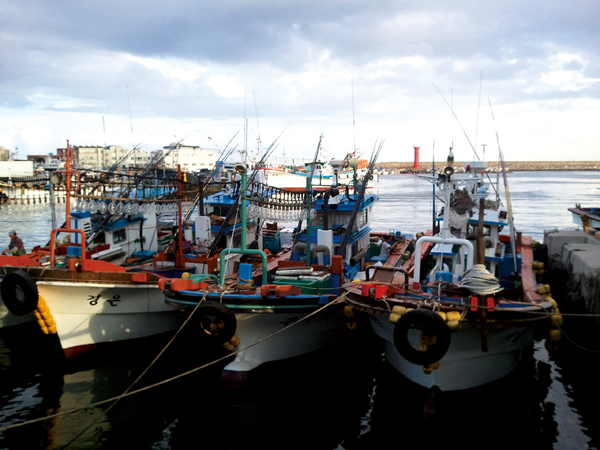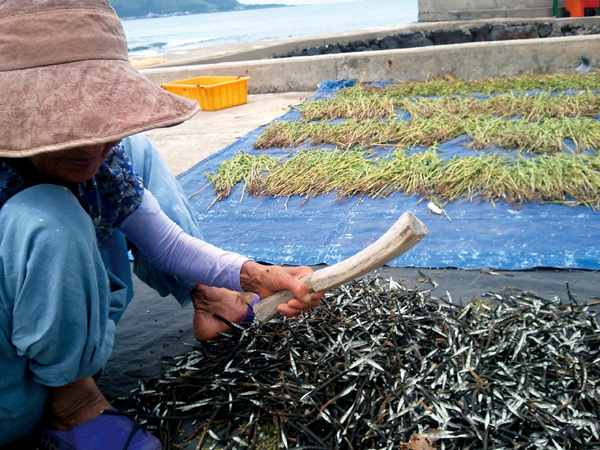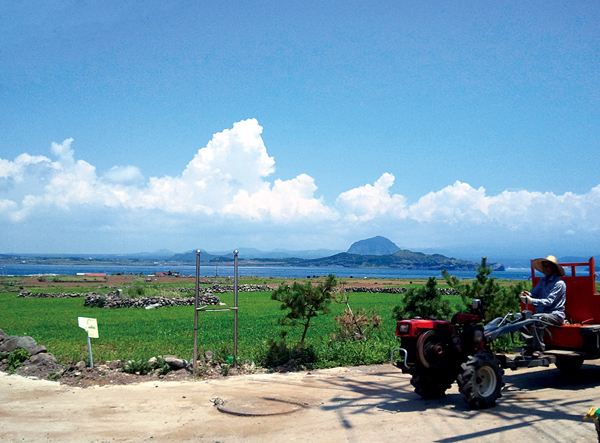
- Updated 2024.12.27 14:37
- All Articles
-
member
icon
-
facebook
cursor
-
twitter
cursor
|
TravelThings To Do |
Tales from the Olle pathOne reporter’s journey and reflections on traversing the famed trail network |
|
This past summer I set out on what proved to be a remarkable journey: trekking the full Jeju Olle course network, entirely alone.
As a researcher of Jeju culture, I knew that Jeju Olle trails, winding not only past natural wonders but through numerous small villages and historic sites, would provide a unique research track. Walking alone was essential not only for the many hours of contemplation it provided but also to encourage interaction between myself and Jeju people.
Each trek began soon after sunrise. Choosing Udo (course 1.1) as my starting point, no sooner did I set out than I was greeted by the sight of a dolphin pod at play — a fortuitous beginning. That day must have been an ideal one for diving, as I noted more than a dozen haenyeo groups (women free-diving communities) dotting the Udo coastline. As a student at this summer’s haenyeo school in Hansupul, I felt a kinship with these women.
Indeed, divers everywhere welcomed me as soon as they heard I was “haenyeo haksaeng” (haenyeo student).
Just four trails into my journey, I learned of the murder of a 40-year old woman on Olle Course No. 1. Many Jeju citizens, especially women, counseled me to cease trekking alone or even abandon my endeavor altogether. After much consideration, I determined to continue as planned, taking safety precautions including my knowledge of self-defense as well as human psychology, and even the carrying of weapons.
It was not until I entered Gotjawal, however — Jeju’s singularly dense forest — that I felt fearful profoundly alone and in the play of shadows. I walked the first such trail with a weapon in each hand and sweat on my brow. When the course exited the dark forest I breathed a sigh of relief, only to find that a second Gotjawal trail was soon expected.
Summoning my courage and setting aside my fear — and my weapons — in order to welcome the tranquility of this unique environment, I found butterflies surrounding me as a doe looked on from nearby.
There’s no sense in denying fear, I thought to myself — indeed, it makes us cautious — but if it takes up residence in one’s mind and heart, it will paralyze. Better to carry those fears in one’s backpack — ready, if necessary, to be brought out at a moment’s notice, mixed with rage and hatred and the right to survive that become a white-hot flashpoint of self-defense.
Fortunately, I never needed it. Many grandmothers along the way, however, made it clear that I should be walking with a friend. One, a small woman likely in her 80s and working alone in her field, took my arm and offered to walk with me.
Much has been said about the healing power of Jeju Olle. Following my sixth course, I found myself heartbroken by the sudden death of my beloved dog. It took me a week to return to the trails, and when I did, walking beautiful Olle Course No. 6, I cried for six hours. Two days later, on equally magical Course No. 7 along the southern coastline, I invited the spirit of my dog to join me on my journey — and talked to him the entire way. Several later trails would take me to places where I’d trekked with him, bringing fresh tears — including, ultimately, the course that passes near his grave. On that day, my grieving was released.
One of the most exciting trails for me was Course No. 10, from Hwasun Beach to Moseulpo. A popular trail, it was on that day, empty save for myself, as Typhoon Damrey was hitting Jeju from the southeast traveling northwest, crossing precisely at Olle’s 10th course. As I clung to rockface well above sea level, nevertheless assaulted by waves as I searched for each safe foothold to be taken in turn during those few seconds that the waters receded, I knew that this was one of the stupidest — and most exhilarating — things I’d ever done. The swirling waters below and fierce winds above made their point crystal clear: one false step would be my last.
I have only begun to sift through the vast wealth of material — direct experience, conversation, photographs, video, research notes, and audio recordings — gathered during my journey. Jeju resides deep within me now. What I have internalized may take me years to fully comprehend.
Here, however, are some of the highlights:
Life in the village is still one of communal living, as people work together in the fields and sea, harvesting and clearing the land, building and resting in the shade. However, most of these people are visibly of the elder generation.
Jeju people’s relationship to nature is woven throughout the fabric of their culture. One cannot be understood without a deep knowledge of the other. Lately, the term “eco-cultural tourism” has been appearing in public sites in direct acknowledgment of this.
A history of oppression can be seen in Japanese bunkers and airfields, Mongolian fortresses, stone lookouts for pirates and other invaders from the sea, and sites of mass graves from mid-20th century military executions. Coupled with the many examples of cultural obliteration brought about by the New Villages Movement of the 1960s and 70s as well as general trends of modern-ization, the heavy toll demanded of Jeju’s indigenous culture is evident.
Shamanic places of worship can still be found everywhere, however if you know where to look, and what you’re observing when you find it. Primarily known as ‘halmang-dang’ or goddess shrines (Jeju mythology is matrifocal, with the same dialect word for both ‘grandmother’ and ‘goddess’), the ‘haesin-dang’ coastal shrines to the sea deities are especially prevalent, and those to maiden goddesses poignant.
Jeju’s urge to tell its story — found in the Kim Man Deok shrine and Chusa Exile Memorial, the many haenyeo artifacts and the Independence Hall, the Jeju Massacre sites and shamanic shrines, Udo’s ‘Storytelling’ signage, and ‘Village History’ signboards across the island, as well as the eagerness of Jeju people to chat with strangers — is evident.
The story of Jeju is there for all Olle walkers to hear if, with open hearts, we listen.
Dr. Hilty is a cultural health psychologist from New York who has now made Jeju Island her home.
|
|
|
|
|
|
|
|
ⓒ Jeju Weekly 2009 (http://www.jejuweekly.net)
All materials on this site are protected under the Korean Copyright Law and may not be reproduced, distributed, transmitted, displayed, published without the prior consent of Jeju Weekly. |
|
|
|
|
| Jeju-Asia's No.1 for Cruise |
|
|
|
Title:The jeju Weekly(제주위클리) | Mail to editor@jejuweekly.net | Phone: +82-64-724-7776 Fax: +82-64-724-7796
#503, 36-1, Seogwang-ro, Jeju-si, Jeju-do, Korea, 63148
Registration Number: Jeju, Ah01158(제주,아01158) | Date of Registration: November 10,2022 | Publisher&Editor : Hee Tak Ko | Youth policy: Hee Tak Ko
Copyright ⓒ 2009 All materials on this site are protected under the Korean Copyright Law and may not be reproduced, distributed, transmitted, displayed, published
without the prior consent of jeju weekly.com.

|
























